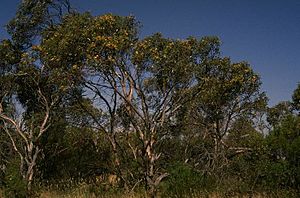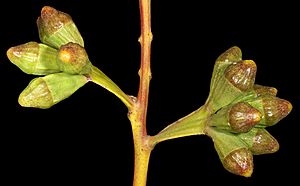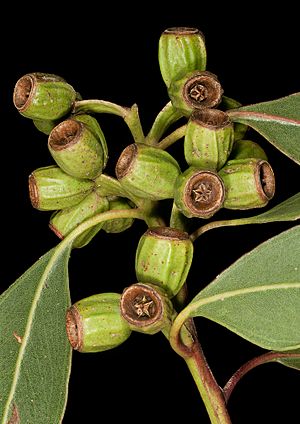Ridge-fruited mallee facts for kids
Quick facts for kids Ridge-fruited mallee |
|
|---|---|
 |
|
| Eucalyptus angulosa | |
| Scientific classification | |
| Genus: |
Eucalyptus
|
| Species: |
angulosa
|
| Synonyms | |
|
|
The ridge-fruited mallee (scientific name: Eucalyptus angulosa) is a special type of eucalyptus tree. People also call it the southern ridge-fruited mallee. This amazing plant grows naturally in Western Australia. The Noongar people, who are the traditional owners of the land, have their own names for it: quarral or kwaral.
Contents
What Does the Ridge-Fruited Mallee Look Like?
This mallee usually grows to be about 1.5 to 7 meters (5 to 23 feet) tall. It has smooth bark that can be grey, white, or even pinkish. Sometimes, you might see loose strips of rough bark near the bottom of the tree.
Leaves and Flowers
The leaves of the ridge-fruited mallee are thick and shiny green. They are shaped like a spear or a wide oval. Each leaf is about 5 to 14 cm (2 to 6 inches) long.
This plant produces beautiful flowers that are white or creamy yellow. You can usually see them blooming between August and March.
Special Features: Lignotuber and Fruit
The ridge-fruited mallee has a special part called a lignotuber. This is a woody swelling at the base of the stem. It helps the plant regrow after a fire or damage. Because of this, one plant can have many stems!
The fruit of this mallee is quite unique. It's shaped like a cylinder or a pot and is about 1 to 2.5 cm (0.4 to 1 inch) wide. It has rough ridges along its sides. Inside, you'll find small, blackish-grey seeds.
Where Does the Ridge-Fruited Mallee Grow?
You can find the ridge-fruited mallee mostly along the coast of Western Australia. It likes to grow on sandy soils, often over limestone rocks. It's common in the Great Southern and Goldfields-Esperance areas.
This plant also grows in South Australia, but it's not as common there. You might spot it on the southern Eyre Peninsula or the southern Fleurieu Peninsula.
How is the Ridge-Fruited Mallee Used?
People can buy this plant as small seedlings or seeds. It's a great choice for gardens because it's very pretty. It's also used to help bring land back to health, especially in areas that have been damaged.
This mallee grows slowly but is very tough. It can handle salty conditions and dry weather, which means it doesn't need a lot of water. It likes to grow in sunny spots and is easy to take care of.
Naming the Ridge-Fruited Mallee
The first time this plant was officially described was in 1843. A botanist named Johannes Conrad Schauer gave it the scientific name Eucalyptus angulosa.
The word angulosa comes from a Latin word meaning "angled." This name refers to the angled shape of the plant's branches and flower buds.



